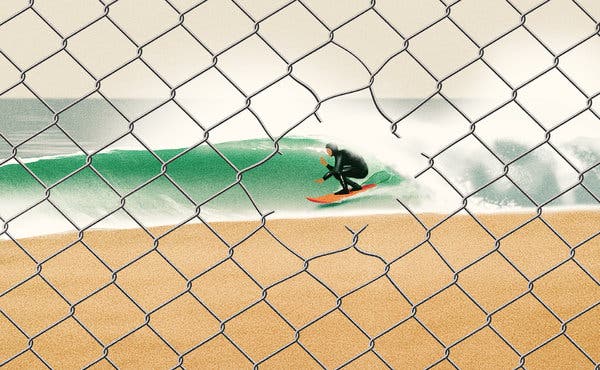Advertisement
It has been widely banned, even though it can be therapeutic and done in accordance with social distancing rules.
By Zoltan Istvan
Mr. Istvan is the author of “The Futuresist Cure: Notes From the Front Lines of Transhumanism.”

MILL VALLEY, Calif. — Many surfers like me believe that surfing is more than just a sport; we consider it a way of life. Being in the ocean and riding waves can be ecstatic and spiritual.
But because of the coronavirus pandemic, many beaches and surf spots around the world are off limits. Citations have been issued for riding waves. On Instagram, you can watch a stand-up paddleboarder surfing Malibu alone for a blessed time before Los Angeles County Fire Lifeguards chase him down in a boat and arrest him.
I learned to surf in California when I was 10 years old in the early 1980s, and I still ride waves as often as possible. I usually go to a popular reef break called the Patch, which is a 30-minute drive from my home here in the Bay Area. The Patch is a softly peeling right-hander set among picturesque redwood-forested mountains, located just off the main beach in a reclusive hippie town called Bolinas. It’s a place where day-tripping San Franciscans and locals hang out on the sand, smoke pot and build fires on the beach while their dogs frolic at the water’s edge.
Once the coronavirus came, so did a Bolinas lockdown. Concerned citizens and government officials put up signs along the road into town, reading “Surfers Stay Home, Save Lives” and “Beaches Closed Due to Covid-19.” Some residents even stood along the road and yelled at cars with surfboards on their roofs to turn around.
I don’t think many surfers obeyed. I didn’t. I just couldn’t see how walking out of my house, getting into my car, parking near the beach, and paddling into waves could be dangerous for anyone. Even on the beach — which hasn’t been crowded since the pandemic hit — most people were wearing masks and practicing social distancing. In the water, we were always considerably more than six feet apart from one another.
The question in Bolinas — to surf or not to surf — is not just a local one. Many of the best waves in California, such as Steamer Lane in Santa Cruz, are walking distance from densely populated downtowns, complicating quarantine directives. This is also true of many surf spots worldwide.
Exercise is important, especially during stressful times. But many surfers, including myself, also use surfing as a form of healing and therapy. I spent a lot of time tearfully in the water after my father died three years ago. Like thousands of others, I consider surfing an essential activity.
Our governor, Gavin Newsom, and other state authorities don’t seem to care much about surfing as a way of life. Up and down the coast, they have threatened surfers with $1,000 fines and closed off beaches, including one of the most famous surf spots, Trestles, in Orange County.
Similar crackdowns have occurred at other renowned spots around the world, including Mundaka in Spain, Surfers Paradise in Australia and Jeffreys Bay in South Africa.
A few days ago, a county sheriff’s officer stood outside his vehicle in the parking area of the beach in Bolinas, waving off visitors and telling surfers to go home. Like many other surfers, I avoided him by parking on a side street. I suited up and after making sure he was looking the other way, sprinted to the water. I caught my first wave of the day a minute later.
I understand that quarantine rules must apply to everyone or the plan to flatten the curve doesn’t work. But I doubt that surfing alone jeopardizes the health of society in any statistically meaningful way, especially because all the surfers I’ve seen have been careful to practice social distancing in and out of the water. The physical, mental and spiritual benefits to surfing outweigh the tiny chance a surfer might become infected or infect someone else.
I prefer how Hawaii, surfing’s home, has handled the situation. While relaxing on the beach is forbidden, swimmers and surfers can go in the water so long as they stay six feet from one another. That policy seems fair and sensible.
A handful of closed beaches throughout the United States are now being reopened, with social distancing rules in place. But many remain off limits and are likely to stay that way at least through May, if not longer. I hope the authorities in those states and localities will consider allowing responsible surfers in the water.
Zoltan Istvan is the author, most recently, of “The Futuresist Cure: Notes From the Front Lines of Transhumanism.”
The Times is committed to publishing a diversity of letters to the editor. We’d like to hear what you think about this or any of our articles. Here are some tips. And here’s our email: letters@nytimes.com.
Follow The New York Times Opinion section on Facebook, Twitter (@NYTopinion) and Instagram.





Recent Comments